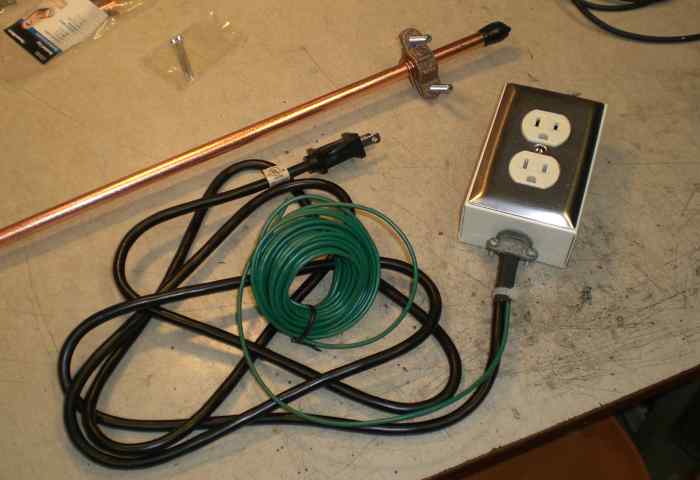The heavy-duty, properly-grounded, from-scratch version.
Older buildings sometimes lack a third safety ground connection on the AC outlets. A small adapter can be purchased to accept a 3-prong plug and convert it to a 2-prong plug plus a tab for connecting an auxiliary ground wire. The intent is to connect the tab to a reasonbly well-grounded object such as the outlet junction box (if it is grounded) or a metal water pipe. Ideally the main panel box will also have a ground rod, but lacking that, most shared residential services have enough other grounds installed somewhere that current will find a return path to the source.
Too often, the adapter is slapped onto the plug and connected to mains AC without another thought. Even when the adapter is used properly, the exposed tab is often flimsy and easily damaged. There is also the problem that older houses may have sections of plubming renovated with plastic materials such as PVC or PEX, and a continous metal water pipe connection back to earth may not even exist in some parts of the structure.
I needed a grounding adapter in the summer of 2007 when I rented a room in an old house in order to be closer to a new job. I had a desktop computer to set up, and computers always run their internal ground plane and power supply safety ground to the system chassis. Since the chassis further acts as a shield for the massive quantities of RFI generated inside, an ungrounded chassis can sometimes develop a substantial float charge. Snap and pop are two sounds one doesn't want to hear around sensitive electronic components, and user safety is also not a trivial concern.
The main panel box had been upgraded at some point and the neutral was earth grounded, but several rooms on the far end of the house hadn't heard about it. All I had available was a two-wire, polarized outlet and no ground source other than the soil below the bedroom window.
I wanted a ground adapter that could take a bit of abuse under a desk, and I needed to reach earth. Solution? Build it from scratch, and run a wire through a window to a proper ground rod. After a trip to a hardware store and twenty minutes of build time, this was the result:

Figure 1. An industrial grade grounding adapter.
The copper-clad steel ground rod and bronze clamp are standard hardware for service panel grounding. The rest required basic assembly. The green ground wire connects to the safety ground in the outlet, and the cord (intended as a heavy-duty power tool replacement cord) features a polarized plug and connects to the appropriate outlet contacts using ring terminals.
The stake was driven into the earth outside the nearest window. The ground wire was run through a small hole in the corner of the bug screen, and connected to the clamp. Finally, the plug was connected to the wall outlet. Voila -- a high-quality, heavy-duty, grounding adapter.
Want to make one like it? Here is a basic bill of materials:
The assembly is straightforward. The antioxidizing compound can be omitted but it helps keep the terminal wiring connections clean over time. The ring terminals are required because the appliance cord has stranded wire, which the plug's terminals are not designed to use. The metal or plastic sheet was required because the back side of my indoor-type surface mount box needed some sort of rear cover. (Alternately, an outdoor-type box could be used). I also cut my ground rod down to about a six-foot length. This wouldn't pass a code inspection for a permanant installation but the soil outside the window wasn't ideal for getting a full 10-foot drive and I didn't know for certain what else might be buried out there if I tried to go that deep.Outlet: Standard NEMA-type 120V outlet in your choice of colors and styles. Cover plate: Standard cover plate to match the outlet. Box: Extra-deep, powder-coated, surface mount electrical box. Cord: Heavy duty, 2-wire replacement cord, your choice of length. Ground wire: Small spool of AWG#14 or larger electrical wire. Ring terminals: Insualted-sleeve type with crimp connections. Galvanized wire clamp: Standard clamp for an electrical box outlet (match the diameter to the box holes.) Ground rod: Standard 10-foot by 3/4" diameter copper-clad steel ground rod. Ground rod clamp: Standard bronze grounding clamp. Anti-oxidizing compound (optional): Usually sold for protecting aluminum wiring connections. Misc. supplies: Heat-shrink tubing, nylon wire ties, small section of metal or plastic sheet.
I used a section of heatshrink tubing and a wire tie to further protect the point where the wires exit the box, particularly since the clamp will not easily secure the ground wire on account of the AC cord being much thicker.
Total cost of materials was fairly low. Total assembly time, an hour or less, depending how fast you work. Just make certain that you know how to correctly wire the Active (hot) and Neutral connections from the cord to the correct terminals of the outlet, and can secure the ground wire appropriately, as well. A poorly-constructed adapter will be worse than none at all. §
aaronv dot net -at- gmail dot com